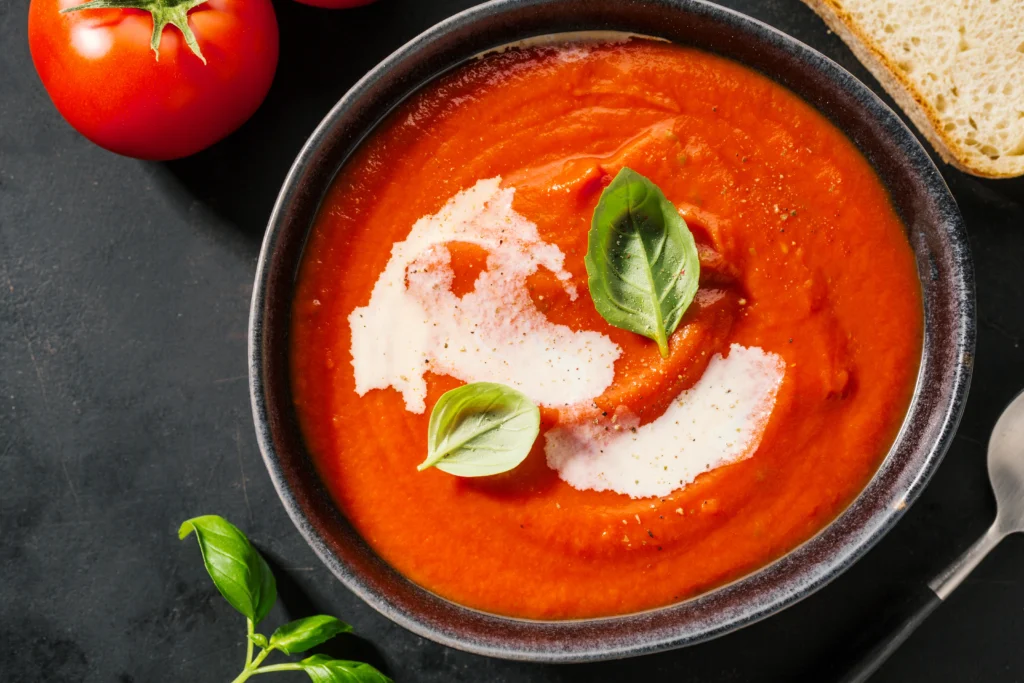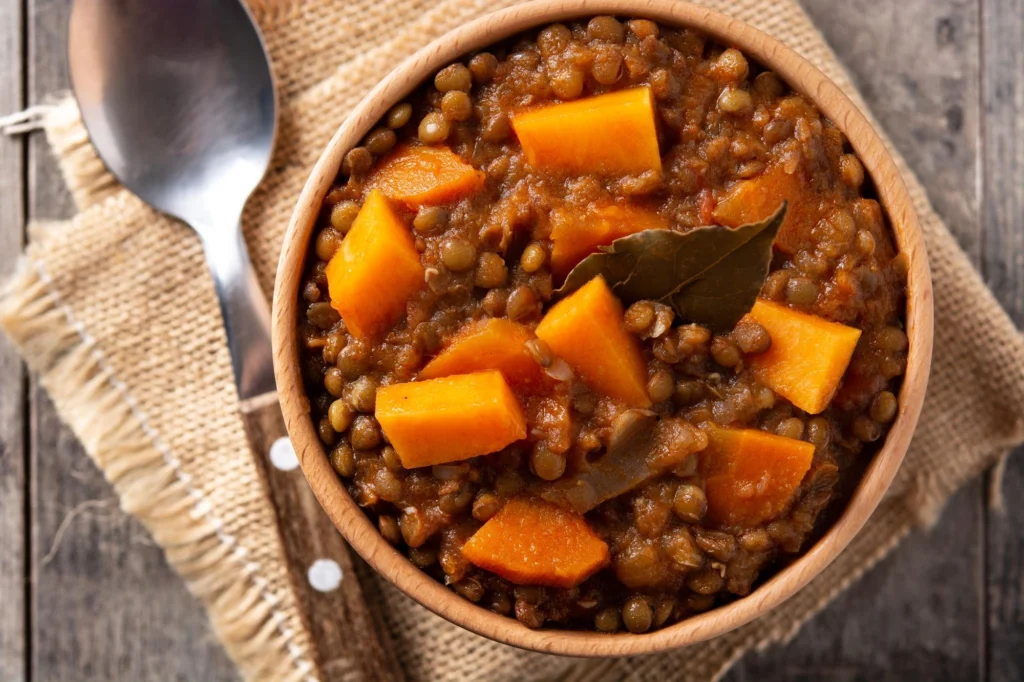Soup season is here, and nothing beats the comfort of a steaming bowl of vegan soup. For those who enjoy preparing meals in advance, vegan crockpot recipes provide an easy and flavorful way to stay on track with plant-based eating. Vegan soup recipes not only taste amazing but also cater to various dietary needs while supporting a plant-based lifestyle. For hearty and satisfying dishes, these vegan casserole recipes make excellent companions to any meal plan. This article covers the benefits, essential ingredients, and simple recipes that will leave you feeling nourished and satisfied. Let’s dive in!
Why Vegan Soups Are a Healthy Choice
Soup is the ultimate comfort food, and choosing vegan options offers extra health benefits. Plant-based soups pack essential nutrients like vitamins, fiber, and antioxidants, which improve overall well-being. They’re naturally low in calories, making them an excellent choice for managing weight. Moreover, vegan soups suit people with allergies or dietary restrictions because they exclude dairy, gluten, or animal-based ingredients. These recipes also simplify meal preparation, making them ideal for busy weeknights.
What Makes a Soup Vegan?
Creating vegan soups involves swapping all animal-based products for plant-friendly alternatives. For example, you can replace chicken broth with vegetable broth, as highlighted in these vegan gluten-free recipes that emphasize wholesome and inclusive ingredients. Instead of using dairy cream, try coconut milk, cashew cream, or blended potatoes for that creamy texture. Hearty ingredients like lentils, tofu, or jackfruit replace meats in traditionally heavy soups, similar to the protein-packed options found in these vegan casserole recipes. These simple adjustments allow you to enjoy diverse, comforting soups while staying true to a vegan lifestyle.
Benefits of Vegan Soup Recipes
Vegan soups are more than just a delicious meal; they offer a range of benefits that make them a must-have in your diet. Whether you’re looking to improve your health, reduce your environmental impact, or enjoy a satisfying meal, vegan soup recipes deliver on all fronts.
Nutritional Benefits of Plant-Based Soups
Plant-based soups are nutritional powerhouses. Packed with fiber, essential vitamins, and minerals, they support digestion, boost immunity, and promote overall health. Ingredients like lentils, chickpeas, and leafy greens provide plant-based protein, while vegetables such as carrots, sweet potatoes, and broccoli add antioxidants and vital nutrients. A bowl of vegan soup not only satisfies hunger but also fuels your body with wholesome goodness.
These soups also help with weight management. Thanks to their low-calorie density, you can enjoy generous portions without worrying about overeating. For those seeking to lower cholesterol or maintain healthy blood sugar levels, the natural ingredients in vegan soups provide significant support.
Environmental Impact of Vegan Soups
Choosing vegan soups contributes to a sustainable and eco-friendly lifestyle. Plant-based diets generally require fewer natural resources compared to meat-based diets. By eating more vegan meals, you reduce water usage, greenhouse gas emissions, and deforestation linked to food production. Plus, soups are perfect for reducing food waste. Leftover vegetables and pantry staples can easily transform into a hearty, nutritious meal.
When you opt for plant-based soups, you’re making a positive impact not only on your health but also on the planet. With every bowl, you support sustainable practices that benefit future generations.
Essential Ingredients for Vegan Soup Recipes
Creating the perfect vegan soup starts with the right ingredients. A combination of fresh vegetables, hearty protein sources, and flavorful spices ensures your soups are both nutritious and delicious. Let’s explore the essentials for making vegan soup recipes that everyone will love.
Protein Sources for Vegan Soups
Protein is a key component of any balanced meal, and vegan soups are no exception. Legumes like lentils, chickpeas, and black beans are fantastic options. Not only do they provide protein, but they also add texture and a satisfying bite. Tofu and tempeh are versatile additions that absorb the flavors of the soup beautifully. For a unique twist, include quinoa or wild rice, which offer both protein and fiber.
Vegetables That Add Flavor and Nutrition
Vegetables are the heart of any vegan soup. Root vegetables like carrots, sweet potatoes, and parsnips create a naturally sweet base. Leafy greens, such as kale, spinach, or Swiss chard, boost the nutrient profile while adding a splash of color. Cruciferous vegetables like broccoli and cauliflower contribute antioxidants and a slight crunch. Don’t forget to use aromatics like onions, garlic, and celery to lay the foundation of flavor.
Herbs and Spices for Flavor Enhancement
Herbs and spices are the secret to elevating the taste of your vegan soup. Fresh herbs like basil, cilantro, and parsley brighten the dish, while dried spices such as cumin, turmeric, and smoked paprika create depth and complexity. Add a pinch of chili flakes or cayenne pepper for a spicy kick. For a comforting umami flavor, include a splash of tamari or nutritional yeast.
Vegan-Friendly Broths
The broth is the backbone of any soup, and vegan options don’t disappoint. Homemade vegetable broth is easy to make with scraps from onions, carrots, and celery. If you’re short on time, choose high-quality store-bought vegetable broth. You can also enhance the flavor with miso paste, coconut milk, or blended tomatoes for a creamy texture.
Easy Vegan Soup Recipes for Beginners
Delicious, hearty, and simple to prepare, these vegan soup recipes are perfect for beginners. Each recipe uses easy-to-find ingredients and provides step-by-step instructions, ensuring your meals turn out flavorful and satisfying every time.
Creamy Tomato Basil Soup
Ingredients
- 6 large ripe tomatoes, chopped
- 1 medium onion, diced
- 3 cloves garlic, minced
- 2 cups vegetable broth
- 1 cup coconut milk
- 1 tablespoon olive oil
- 1 teaspoon dried basil
- 1 teaspoon sugar (optional)
- Salt and pepper to taste
- Fresh basil for garnish
Cooking Instructions
- First, heat olive oil in a large pot over medium heat. Then, add the onion and garlic, stirring occasionally until they turn soft and fragrant.
- Next, mix in the chopped tomatoes, dried basil, and sugar (if you prefer a sweeter taste). Allow them to cook for 5-7 minutes until the tomatoes soften.
- After that, pour in the vegetable broth and bring the mixture to a gentle boil. Reduce the heat, and simmer for 15 minutes.
- Once the mixture is cooked, use an immersion blender to purée the soup until smooth. If you don’t have one, transfer the soup in batches to a blender and blend with care.
- Finally, stir in the coconut milk, season with salt and pepper, and simmer for another 5 minutes.
- Serve hot, and garnish with fresh basil leaves for a burst of flavor.
Nutritional Content (Per 100g)
| Nutrient | Amount |
|---|---|
| Calories | 45 kcal |
| Protein | 1 g |
| Fat | 3 g |
| Carbohydrates | 4 g |
| Fiber | 1 g |
Hearty Lentil and Vegetable Soup
Ingredients
- 1 cup dried green or brown lentils, rinsed
- 2 medium carrots, diced
- 2 celery stalks, diced
- 1 medium onion, chopped
- 3 cloves garlic, minced
- 6 cups vegetable broth
- 1 can diced tomatoes (14 oz)
- 1 teaspoon cumin
- 1 teaspoon smoked paprika
- 1 tablespoon olive oil
- Salt and pepper to taste
- Fresh parsley for garnish
Cooking Instructions
- To start, heat olive oil in a large pot over medium heat. Then, add the onion, garlic, carrots, and celery. Cook for about 5 minutes until the vegetables soften.
- Afterward, stir in the cumin and smoked paprika. Let the spices cook for about a minute to bring out their flavor.
- Then, add the rinsed lentils, diced tomatoes, and vegetable broth. Bring the mixture to a boil.
- Reduce the heat to low and allow the soup to simmer for 30-35 minutes, or until the lentils are tender.
- Once the lentils are cooked, season with salt and pepper to taste. If you prefer a thicker consistency, mash a portion of the lentils with the back of a spoon.
- Finally, serve the soup hot, garnished with fresh parsley for added color and flavor.
Nutritional Content (Per 100g)
| Nutrient | Amount |
|---|---|
| Calories | 60 kcal |
| Protein | 3 g |
| Fat | 1 g |
| Carbohydrates | 10 g |
| Fiber | 3 g |
Tips for Making the Perfect Vegan Soup
Crafting the perfect vegan soup doesn’t require culinary expertise, but a few tricks can elevate your creations from good to extraordinary. With these practical tips, you’ll be whipping up delicious vegan soup recipes that are bursting with flavor and texture in no time.
Balancing Flavors
To achieve a well-rounded flavor, focus on balancing salty, sweet, sour, and umami elements. For example, if your soup tastes bland, a pinch of salt or a splash of tamari can instantly enhance it. If it’s too salty, add a squeeze of lemon juice or a splash of vinegar to cut through the intensity. To add depth, consider incorporating a small amount of sugar, maple syrup, or nutritional yeast.
Adding spices in layers is another way to build complexity. Start with aromatic ingredients like garlic, onions, or ginger, then gradually introduce ground spices or herbs as the soup cooks.
Achieving the Right Texture
The texture of your soup plays a crucial role in its appeal. If you prefer a chunky soup, keep your vegetables and legumes in larger pieces. For a creamy consistency, blend a portion of the soup and stir it back into the pot. Alternatively, use plant-based ingredients like coconut milk or cashew cream to achieve a silky, luxurious finish.
Experiment with texture by adding crunchy toppings like roasted chickpeas, croutons, or chopped nuts. These not only create contrast but also add an extra layer of flavor.
Making Soups Ahead of Time
Vegan soups are excellent for meal prepping since their flavors often improve with time. To store them properly, let the soup cool to room temperature before transferring it to airtight containers. Refrigerate for up to five days or freeze for up to three months.
When reheating, stir the soup occasionally to ensure it heats evenly. If it thickens too much while stored, simply add a splash of vegetable broth or water to restore its original consistency.
Avoiding Common Mistakes
One of the most common errors in soup-making is overcooking vegetables, which can lead to mushy textures and muted flavors. Instead, add delicate vegetables like leafy greens toward the end of the cooking process. Another mistake to avoid is under-seasoning. Taste your soup frequently while it cooks and adjust the seasoning as needed.
By following these tips, you can create soups that not only taste great but also provide a satisfying and wholesome meal every time.
Common Mistakes to Avoid When Making Vegan Soups
Even the most experienced cooks can run into pitfalls when preparing soups. By avoiding these common mistakes, you can ensure your vegan soup recipes turn out flavorful, satisfying, and perfectly balanced every time.
Overcooking Vegetables
One of the most frequent errors is overcooking vegetables, which can result in mushy textures and diminished flavors. To avoid this, add vegetables in stages based on their cooking times. For example, root vegetables like carrots and potatoes can go in first, while softer veggies like zucchini or spinach should be added closer to the end. Keeping an eye on your soup as it simmers will help you achieve the perfect texture.
Using Low-Quality Ingredients
The flavor of your soup heavily depends on the quality of the ingredients you use. Low-quality or old vegetables can lead to a bland and uninspiring dish. Instead, choose fresh, seasonal produce for the best taste and nutritional value. Additionally, opt for a high-quality vegetable broth or make your own at home to enhance the base flavor of your soup.
Forgetting to Season Properly
Seasoning can make or break a soup. Many people forget to taste their soup throughout the cooking process, leading to under-seasoned or overly salty results. To ensure your soup is well-balanced, taste it at various stages and adjust the seasoning as needed. Remember to use salt sparingly at first, then add more gradually to avoid overpowering the other flavors.
Neglecting Texture Variety
A soup with a one-note texture can quickly become uninteresting. To create a more dynamic eating experience, combine smooth and chunky textures. For example, blend a portion of the soup and leave the rest chunky, or top your bowl with crunchy additions like croutons, roasted nuts, or seeds.
Ignoring Proper Storage Techniques
Improper storage can ruin even the most delicious soup. Always allow the soup to cool to room temperature before transferring it to containers. Use airtight containers to maintain freshness, and clearly label them with the date to track how long they’ve been stored. Soups can last up to five days in the fridge and three months in the freezer.
By keeping these tips in mind and avoiding these common mistakes, you’ll consistently create soups that are not only delicious but also perfectly balanced and satisfying.
FAQs About Vegan Soup Recipes
Curious about making the most out of your vegan soup recipes? Here are answers to some frequently asked questions to help you create soups that are not only delicious but also tailored to your dietary needs and preferences.
What Are the Best Vegan Soup Recipes for Weight Loss?
Vegan soups are fantastic for weight loss because they are low in calories and high in fiber. Soups like lentil and vegetable soup, creamy cauliflower soup made with plant-based milk, and miso soup packed with greens are great options. These soups keep you full for longer without adding extra calories, making them ideal for weight management.
Can I Freeze Vegan Soups?
Yes, most vegan soups freeze exceptionally well. To freeze, let the soup cool completely before transferring it to freezer-safe containers or resealable bags. Leave some space at the top to allow for expansion as it freezes. Label each container with the name and date, and store them for up to three months. When you’re ready to eat, thaw the soup overnight in the refrigerator and reheat it on the stove.
How Do I Make Vegan Soups Creamy Without Dairy?
There are plenty of ways to achieve a creamy texture in vegan soups without using dairy. Coconut milk, cashew cream, or almond milk are excellent alternatives to heavy cream. Blending cooked vegetables like potatoes, cauliflower, or carrots can also create a smooth, velvety consistency. Nutritional yeast adds a cheesy flavor, while mashed white beans or silken tofu can give soups a rich and thick texture.
What Are Some High-Protein Vegan Soups?
High-protein vegan soups include ingredients like lentils, chickpeas, tofu, tempeh, and quinoa. For example, a red lentil soup with carrots and spices or a chickpea and kale soup delivers plenty of plant-based protein. Adding wild rice or quinoa to soups can also boost the protein content while keeping the dish hearty and satisfying.
Are Vegan Soups Gluten-Free?
Many vegan soups are naturally gluten-free, especially when made with whole foods like vegetables, legumes, and gluten-free grains. However, it’s essential to check the labels of store-bought broths, spice blends, and other processed ingredients for hidden gluten. To be safe, use gluten-free certified products and avoid adding ingredients like regular soy sauce, which contains gluten.
These frequently asked questions address common concerns and provide practical solutions, making it easier for you to enjoy delicious and healthful vegan soups.
Embrace the Warmth of Vegan Soups
Vegan soups are a delightful combination of flavor, nutrition, and sustainability. They’re easy to prepare, versatile, and packed with wholesome ingredients that suit any dietary preference or lifestyle. Whether you’re seeking a hearty meal on a chilly evening or a light, refreshing option for lunch, vegan soup recipes have something for everyone.
Encouraging Readers to Try Vegan Soup Recipes
Why not take the plunge and experiment with some of these easy and nutritious recipes? From creamy tomato basil soup to hearty lentil and vegetable soup, the possibilities are endless. Incorporating these recipes into your routine not only supports your health but also contributes to a more sustainable and environmentally friendly diet.
Share Your Vegan Soup Creations
If you’ve been inspired by these recipes, don’t hesitate to share your culinary creations with others. Snap a photo of your masterpiece, post it on social media, and tag your friends to spread the love for vegan cooking. We’d also love to hear about your favorite variations or personal touches, so feel free to drop a comment and join the conversation!
With these recipes, tips, and ideas, your journey into vegan soup-making is off to a flavorful start. Ready to cook up a storm and enjoy the comforting goodness of vegan soups? Get started today and discover how simple and satisfying plant-based meals can be!


